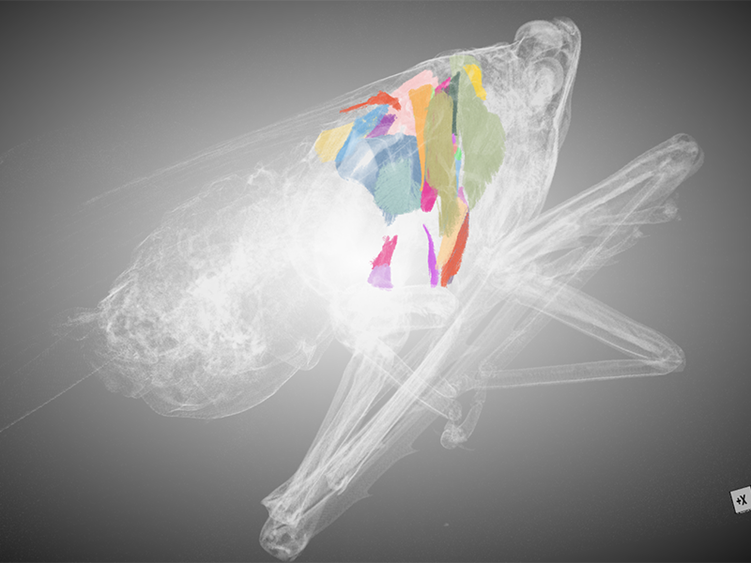
This 3D image of a spotted lanternfly female illustrates the size and position of thoracic locomotory muscles in various colors and the silhouette of the insect in light gray.
UNIVERSITY PARK, Pa. — The spotted lanternfly has become a significant agricultural and ecological challenge in Pennsylvania since its introduction a decade ago. Despite its widespread distribution, basic knowledge about the insect's biology remains limited. To address this gap, a team of Penn State researchers is collaborating with the Penn State Institute of Energy and the Environment's Center for Quantitative Imaging to detail the spotted lanternfly's anatomy and physiology.
“We are using X-ray computed tomography (CT) to document the internal anatomy of the spotted lanternfly,” said Flor Acevedo, an assistant professor of entomology and arthropod ecology at Penn State Behrend. “To date, our knowledge of the spotted lanternfly's internal structure is limited. By documenting the adult anatomy, we aim to establish a comprehensive understanding for future ecological and biological investigations."
Acevedo, who is leading the team, said it is important to understand how the spotted lanternfly moves on its own to stop it from spreading further in the field. Currently, the invasive insect has spread to 51 of Pennsylvania’s 67 counties.
“Despite its ability to walk, jump and fly, CT scans reveal the spotted lanternfly's exceptional jumping prowess is due, in part to its significant leg musculature,” Acevedo said. “In contrast, its wing muscles are less sizeable, explaining its weaker flight capabilities."
One facet of Acevedo’s work includes insects associated with grapes and vineyards.
“When the spotted lanternfly arrived in the U.S., we didn’t know how damaging it could be,” Acevedo said. “Research has shown that they are primarily a nuisance for most plants. However, grapevines are one of their preferred hosts, and some vineyards have been seriously affected by lanternfly feeding.”
To get a clear picture of the spotted lanternfly’s anatomy, Acevedo worked closely with the staff in the Center for Quantitative Imaging. Together, the group identified and tested various methods to differentiate the internal structures in the lanternflies, including staining processes to visualize tissues of interest in CT scans. They found the optimal method to obtain high-resolution images of the insect was fixing and critical point drying, which slowly removes water from the specimen preserving its integrity.
CT scanning allows us to visualize intricate details without destroying the specimen, providing an accurate and clear understanding of insect anatomy.—Flor Acevedo , assistant professor of entomology and arthropod ecology, Penn State Behrend
Odette Mina, managing director of the Institute of Energy and the Environment’s laboratories, said the Center for Quantitative Imaging is a fitting partner to investigate the miniature anatomy of the spotted lanternfly.
"The Center for Quantitative Imaging is a premier open access research facility, providing advanced computed tomography imaging and expert analysis,” Mina said. “Our capabilities extend across diverse fields, from illuminating the inner workings of biological systems to revealing the microscopic structures of materials. We empower researchers and accelerate discovery by transforming invisible complexities into tangible 3D images to explore and understand."
The CT scanning process is a non-destructive imaging technique that captures multiple X-ray scans of an object at different depths. Then, computer software assembles all the scans into a full digital 3D model that shows all the internal and external components of the scanned object in high-resolution detail.
"Traditionally, studying insect anatomy has been a destructive process involving dissection, which can result in distorted representations of internal structures," Acevedo said. "CT scanning allows us to visualize intricate details without destroying the specimen, providing an accurate and clear understanding of insect anatomy."
Acevedo’s research is funded by the Commonwealth Campuses Research Collaboration Development Program, which supports research projects between faculty at the Penn State Commonwealth Campuses and faculty at University Park’s interdisciplinary institutes and the College of Medicine. Students working with Acevedo on the project are Melody Li, Norah Dana and Sukhman Singh.





